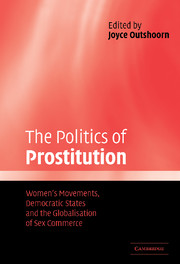 The Politics of Prostitution
The Politics of Prostitution Book contents
- Frontmatter
- Contents
- List of figures
- List of tables
- Notes on contributors
- Preface
- 1 Introduction: prostitution, women's movements and democratic politics
- 2 The women's movement and prostitution politics in Australia
- 3 Taxes, rights and regimentation: discourses on prostitution in Austria
- 4 Prostitution policies in Britain, 1982–2002
- 5 Prostitution as public nuisance: prostitution policy in Canada
- 6 Towards a new prohibitionism? State feminism, women's movements and prostitution policies in Finland
- 7 Prostitute movements face elite apathy and gender-biased universalism in France
- 8 The politics of prostitution and trafficking of women in Israel
- 9 Italy: the never-ending debate
- 10 Voluntary and forced prostitution: the ‘realistic approach’ of the Netherlands
- 11 State feminism and central state debates on prostitution in post-authoritarian Spain
- 12 Criminalising the john – a Swedish gender model?
- 13 The invisible issue: prostitution and trafficking of women and girls in the United States
- 14 Comparative prostitution politics and the case for state feminism
- Appendix 1 Independent variable indicators
- Appendix 2 Worksheets
- References
- Index
12 - Criminalising the john – a Swedish gender model?
Published online by Cambridge University Press: 22 September 2009
- Frontmatter
- Contents
- List of figures
- List of tables
- Notes on contributors
- Preface
- 1 Introduction: prostitution, women's movements and democratic politics
- 2 The women's movement and prostitution politics in Australia
- 3 Taxes, rights and regimentation: discourses on prostitution in Austria
- 4 Prostitution policies in Britain, 1982–2002
- 5 Prostitution as public nuisance: prostitution policy in Canada
- 6 Towards a new prohibitionism? State feminism, women's movements and prostitution policies in Finland
- 7 Prostitute movements face elite apathy and gender-biased universalism in France
- 8 The politics of prostitution and trafficking of women in Israel
- 9 Italy: the never-ending debate
- 10 Voluntary and forced prostitution: the ‘realistic approach’ of the Netherlands
- 11 State feminism and central state debates on prostitution in post-authoritarian Spain
- 12 Criminalising the john – a Swedish gender model?
- 13 The invisible issue: prostitution and trafficking of women and girls in the United States
- 14 Comparative prostitution politics and the case for state feminism
- Appendix 1 Independent variable indicators
- Appendix 2 Worksheets
- References
- Index
Summary
Introduction
A state with ‘feminism without feminists’ is how Sweden at times has been pictured (Gelb 1989, in Florin and Nilsson 1999: 64–5). In a country as organised as Sweden, extra-parliamentary groups and other protest groups seem to be absorbed by the state and there is no place for militant feminism. Since the 1960s the Swedish state has partly integrated what has been called a ‘Swedish gender equality discourse’. This led to a number of changes in laws, a Ministry of Equal Status in 1976, a Parliamentary Commission on Equal Status in the same year, and the creation of the Equal Opportunities Ombudsman in 1980. It has been argued that a number of ‘policy entrepreneurs’ and feminist agents were necessary to spread ideas on gender equality and to politicise the issue (Florin and Nilsson 1999: 65, 73). However, this gender equality policy mainly focused on women's right to work and equal pay; issues of sexuality were less debated.
This chapter will show that there was more or less unanimous support among the feminists in the established political parties for seeing prostitution as patriarchal oppression of women. Opinions have diverged on how to deal with this question, whether non-criminalisation, criminalisation of both parties or just criminalising the john was the right way to proceed. To legalise prostitution has never been an issue among feminists in parliament during the past thirty years.
- Type
- Chapter
- Information
- The Politics of ProstitutionWomen's Movements, Democratic States and the Globalisation of Sex Commerce, pp. 225 - 244Publisher: Cambridge University PressPrint publication year: 2004
- 22
- Cited by


